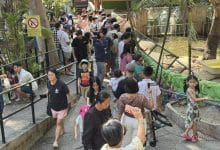Tourists report smelly water at northern Thailand waterfall

Visitors to Phu Soi Dao National Park in northern Thailand are raising concerns over the origin of the water from the Sai Thip Waterfall. Reports of an unusual smell from the water have sparked debate and curiosity among tourists.
Phu Soi Dao, covering areas in Nam Pat and Ban Khok districts in Uttaradit province, as well as Chat Trakan district in Phitsanulok province, is renowned for its beautiful natural scenery and challenging hiking trails. The national park, which reaches a height of 2,120 metres, is the fourth highest peak in Thailand and attracts adventure seekers with its 6.5-kilometre trek to a pine forest plateau.
The hike, which takes between four to eight hours, offers breathtaking views of rare flowers and cascading waterfalls. Despite the park’s popularity, recent events have led visitors to question the quality of the water at one of its main attractions.
A post on a Facebook group dedicated to Phu Soi Dao enthusiasts has gone viral after a tourist shared his experience at the Sai Thip Waterfall. They visited the location and noticed that the water level was low. A friend who washed his face with the water reported a strange smell, prompting the group to ask, “Where does this water come from? Does anyone know?”
The post elicited numerous responses, with several commenters providing insights that left many readers unsettled. One commenter confidently claimed that the waterfall’s water came from the nearby toilet facilities, suggesting that the water, which had a strong urine smell, was recycled from the restrooms.
“The water comes from the toilets. It was disheartening, and the smell was strong. Officials should remove the signs. It’s not funny when people get disappointed.”
Another person recounted finding sanitary waste in the water and expressed their disgust upon realising its origin. They explained that a stream behind the toilet supplies water to a tank on the hill, which is then used in the restrooms. After use, the water flows back into the stream and continues to the waterfall, with some being recycled into the tank once more.

Further discussions revealed that the water used in the restrooms and waterfall might also contain residues from community washing processes and sewage-like smells. Some visitors noted that during their visit, the water contained a detectable odour, yet still, people swam in it.
Questions were also raised about the proximity of the toilets to the stream, with suggestions to implement modern wastewater treatment systems to prevent contamination.
“Why are the toilets so close to the stream? They should have treatment systems before releasing water.”
Another observation was that if the park was crowded, the waterfall’s flow would be stronger, hinting at the water’s origin.
The situation seems to depend on the weather as well, with heavy rain potentially flushing out contaminants, resulting in cleaner water. However, less rainfall could lead to the water retaining a noticeable scent, affecting both the tap water in the restrooms and the waterfall.
As the debate continues, visitors and nature enthusiasts hope for clarity and solutions to ensure a safe and pleasant experience at Phu Soi Dao National Park, reported KhaoSod.
Frequently Asked Questions
Here are some common questions asked about this news.
Why might the water at Sai Thip Waterfall have an unusual smell?
Possible contamination from restroom recycling processes and proximity to waste sources may affect the water quality at the waterfall.
How could modern wastewater treatment systems improve the situation at Phu Soi Dao National Park?
Implementing advanced systems could prevent contamination, ensuring cleaner, safer water for visitors and the environment.
What if the park officials addressed the water quality concerns proactively?
Enhancing water quality could improve visitor experiences, sustain tourism, and protect the park’s natural reputation.
How does weather impact the water quality at the waterfall?
Heavy rain may flush out contaminants, improving water quality, while less rainfall can lead to more noticeable scents and impurities.
What role does visitor density play in the water flow of the waterfall?
Higher visitor numbers may increase water flow, possibly linking restroom usage to the waterfall’s water supply dynamics.
Latest Thailand News
Follow The Thaiger on Google News:


























